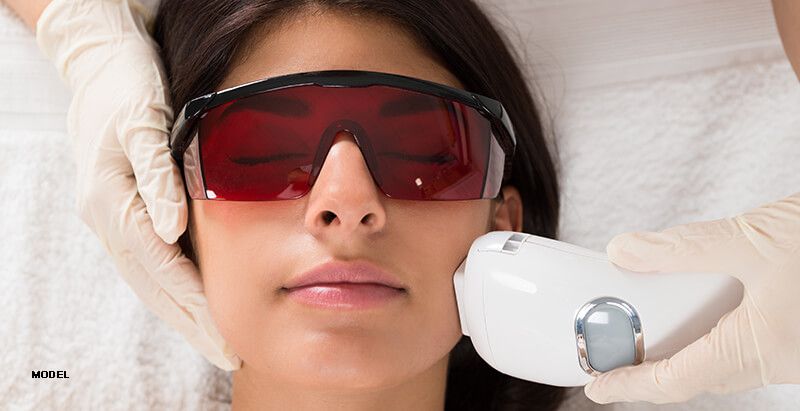How To Care For Skin After Laser Skin Resurfacing

Laser skin resurfacing is an effective treatment for reducing the appearance of scars, acne, wrinkles, fine lines, and discoloration. After a period of healing, skin appears brighter, smoother and more youthful. Some types of laser resurfacing are more intense than others, but proper post-treatment care is important regardless of the type of laser used. Proper aftercare can enhance the results of the procedure and minimize any unwanted side effects like dryness, irritation, and flaking.
Here’s What to Expect After Laser Resurfacing Treatment
After laser resurfacing treatment it’s common to experience redness, swelling, itching or stinging, and a mild sunburn-like feeling. Treatments that go deeper can also incur a period of extreme dryness and flaking as skin heals. The degree of peeling and flaking is related to the depth of your laser resurfacing treatment.
Some lasers treat only the superficial layers of the skin, resulting in mild peeling that lasts approximately one week. Others, such as CO2 lasers or Fraxel treatments penetrate skin more deeply, resulting in more extreme peeling. Your doctor will let you know what to expect depending on the type and depth of the laser treatment you had.
Aftercare Basics
Swelling can be managed by keeping your head elevated or using a cool compress. In cases of a deeper peel, your doctor may prescribe steroids to reduce swelling around your eyes.
Following a deep laser resurfacing treatment, you may be sent home with the treated areas bandaged. After the first 24 hours, you’ll begin a daily cleaning regimen to prevent infection and promote healing. This includes gently cleaning the area 4-5 times daily, followed by generous application of a healing ointment, which prevents scabbing.
Avoid wearing makeup until peeling or flaking has fully healed. At this point, there may be some residual redness you’d prefer to cover up until skin has healed completely.
How Long Does The Skin Take To Heal?
After a mild chemical peel, swelling and itching typically subside within 1-3 days, while peeling and flaking heal within one week. Healing takes longer after a deep chemical peel, and may take 3-4 weeks.
While recovering from laser skin resurfacing does take time, results can last for several years.
NEVER Pick at Flaking or Peeling Skin
As your skin heals, it will naturally begin to peel and flake. It’s of utmost importance NOT to pick at flaking or peeling skin, but to allow this process to happen on its own timeline.
Attempting to speed up the peeling process can lead to the following negative outcomes:
- Irritation
- Breakouts
- Allergic Reaction
- Infection
- Permanent Discoloration
- Scarring
Dry, peeling or flaking skin serves an important function – it protects the new skin underneath. During the healing process, it can be helpful to think of your skin’s rough surface as a band-aid. This band-aid will naturally exfoliate on its own – but only when the skin underneath is ready to be revealed.
Tips: Caring for The Skin After Laser Resurfacing
In addition to practicing patience and never picking at peeling or flaking skin, the following tips will help ensure your skin heals as it should, for the best possible results.
Avoid Excessive Sweating
For at least 3 days following your treatment, avoid strenuous exercise, swimming or sweating. This can lead to breakouts or infection and may negatively affect your final results.
Avoid Harsh Skincare Ingredients
To minimize irritation, avoid harsh, irritating or exfoliating skincare ingredients in the days leading up to your treatment, and until you’re completely healed. This includes hydroxy acids, retinols, and even serums such as Vitamin C.
Clean Your Skin Regularly
Closely follow your doctor’s recommendation to gently wash your skin 4-5 times daily with water or a diluted cleanser. Follow each cleaning with moisturization using the cream your doctor recommends. This prevents infection, minimizes scabbing, and will help your skin heal faster.
Protect Skin from the Sun
When outside, use a high-SPF sunscreen and remember to reapply every few hours. Mineral sunscreens with titanium dioxide or zinc oxide as their active ingredients are less irritating for peeling or flaking skin.
Use a Vinegar Soak
A vinegar soak has antimicrobial properties which can help soothe and heal skin. To do it, soak gauze strips in one cup of water, with 1 spoonful of vinegar added. Gently rest the gauze on your face, then remove it after 10-15 minutes. Resist rubbing!
Use Sterile Scissors to Cut Away Large Flakes
With your doctor’s permission, you might cut away large flakes of skin using sterile scissors. This should NOT be confused with picking or peeling. Cut only flakes that are long enough to trim, and be very careful not to tug at or nick your skin in the process. Use clean hands and scissors that have been sterilized in alcohol or antiseptic solution.
Practice Patience
Finally, give yourself the luxury of allowing for time to heal. Plan your laser resurfacing treatment away from big events. Intentionally scheduling downtime for healing can foster patience and help you resist exfoliating or picking at flakes. This lets the healing process happen on its own timeline, which will ensure the best possible results.
Disclaimer: The contents of the Westlake Dermatology website, including text, graphics, and images, are for informational purposes only and are not intended to substitute for direct medical advice from your physician or other qualified professional.

Ideally, you shouldn’t use cosmetics that aren’t of a medical grade while you’re recovering. Your best chance is to use products made for skin before and after a laser treatment because your skin will be incredibly sensitive for weeks or even months following your procedure. Thanks for sharing this post.